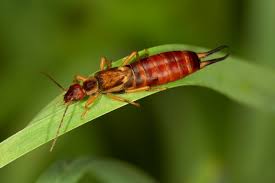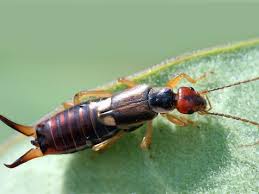Earwigs, scientifically known as Dermaptera, are fascinating insects that often evoke a sense of curiosity and, at times, fear. These small creatures are easily identifiable by the distinctive pincers or forceps at the end of their abdomen, which resemble small tweezers. Despite their somewhat intimidating appearance, earwigs are generally harmless to humans and play important roles in the ecosystem.
Earwigs are distributed worldwide, with a diverse range of species adapting to various environments. They can be found in gardens, forests, and even urban areas. These insects are characterized by slender bodies and typically measure between 5 to 25 millimeters in length, depending on the species.
One of the most distinctive features of earwigs is their forceps, or cerci, which are often misconceived as harmful weapons. However, these pincers serve multiple purposes, including mating rituals, defense mechanisms, and assisting in capturing prey. Contrary to popular belief, earwigs do not enter human ears, as their name might suggest.
These insects are primarily nocturnal, preferring to be active during the night. They are omnivorous, feeding on a varied diet that includes plant matter, small insects, and decaying organic material. Their scavenging habits contribute to ecosystem balance by aiding in the decomposition process.
Earwigs undergo incomplete metamorphosis, meaning they go through a series of molts before reaching adulthood. The life cycle typically consists of an egg stage, nymphal stages, and finally, the adult stage. Female earwigs exhibit maternal care by tending to their eggs and nymphs, showcasing a level of parental involvement uncommon among insects.
While earwigs are generally beneficial in controlling pest populations, they can become nuisances in gardens and agricultural settings. Despite their potential for damage to crops, the benefits they provide in terms of pest control often outweigh the negative aspects.
However, earwigs, or Dermaptera, are intriguing insects with a wide distribution and diverse adaptations. Their unique forceps, nocturnal behavior, and role in pest control contribute to their significance in the natural world. Understanding these creatures dispels common myths and fosters appreciation for the important ecological roles they play.
Read Also: American Bullies: Description, Health, Origin and Complete Care Guide
Plants and Animals Affected by Earwigs (Dermaptera)

Earwigs, as omnivorous insects, have a varied diet that includes both plants and small animals. While they are generally considered beneficial in controlling certain pest populations, they can occasionally have impacts on specific plants and animals.
1. Plants:
Vegetables and Fruits: Earwigs may feed on the soft tissues of fruits and vegetables, causing cosmetic damage. Crops such as lettuce, strawberries, and peaches are sometimes affected.
Flowers: Certain ornamental flowers may be susceptible to earwig feeding. Particularly, flowers with tender petals or buds may experience damage.
Seedlings: Earwigs can pose a threat to young plants and seedlings by nibbling on the delicate leaves. This may hinder the initial growth of crops.
2. Animals:
Insects: Earwigs are opportunistic feeders and may consume other small insects and arthropods. While this behavior contributes to natural pest control, it could impact beneficial insects in the vicinity.
Decomposers: Earwigs play a role in breaking down decaying organic matter. While this is generally beneficial, in certain situations, they might compete with other decomposers for resources.
Small Invertebrates: In their quest for food, earwigs may prey on small invertebrates such as mites and springtails.
It is essential to note that the impact of earwigs on plants and animals varies depending on factors such as environmental conditions, the abundance of alternative food sources, and the specific species of earwig present. While they may cause some damage to certain crops, their overall contribution to pest control and ecosystem balance should not be overlooked.
Proper management strategies, such as maintaining a diverse ecosystem and implementing targeted control measures when necessary, can help mitigate any potential negative effects on plants and animals.
Damages Caused by Earwigs

Earwigs, despite their generally beneficial role in pest control, can occasionally cause damage to plants and certain materials. Here are some of the potential damages caused by earwigs:
1. Feeding on Plant Material: Earwigs may feed on the soft tissues of plants, including leaves, flowers, and seedlings. While they usually target decaying plant matter, they can cause cosmetic damage to crops, vegetables, and ornamental plants.
2. Damage to Fruits and Vegetables: In gardens and orchards, earwigs may nibble on the surface of fruits and vegetables. Although the damage is often superficial, it can affect the marketability and appearance of produce.
3. Feeding on Seedlings: Young plants and seedlings are susceptible to earwig feeding. The tender leaves of emerging plants may be damaged, potentially hindering the growth and development of crops.
4. Impact on Flowers: Ornamental flowers with delicate petals or buds may be vulnerable to earwig feeding. This can affect the aesthetic value of garden plants.
5. Occasional Damage to Crops: In some cases, earwigs can cause economic damage to certain crops, especially if their population is high and alternative food sources are limited.
It’s important to note that while earwigs can cause damage in specific situations, they also play a crucial role in natural pest control by preying on other insects. The extent of damage depends on factors such as environmental conditions, the presence of alternative food sources, and the specific species of earwig.
Integrated pest management (IPM) strategies, which involve a combination of cultural, biological, and chemical control methods, can be employed to manage earwig populations and minimize potential damages. Understanding the balance between their beneficial and detrimental aspects is key to effective earwig management in agriculture and gardening.
Read Also: English Bulldog: Description, Health and Origin
Control and Preventive Measures

Controlling and preventing earwig populations involves a combination of strategies to strike a balance between managing their potential damages and preserving their beneficial role in natural pest control. Here are some measures:
1. Cultural Practices:
Remove Harborages: Clear away debris, mulch, and decaying plant material near the base of plants, as these provide hiding spots for earwigs.
Reduce Moisture: Earwigs thrive in damp conditions, so ensuring proper drainage and reducing excess moisture can discourage their presence.
2. Natural Predators:
Encourage Predators: Attract natural predators of earwigs, such as birds, to your garden. Creating a bird-friendly environment can help keep earwig populations in check.
3. Beneficial Insects:
Introduce Beneficial Insects: Some insects, like ground beetles and parasitic wasps, are natural enemies of earwigs. Encourage these beneficial insects to establish a balance in your garden.
4. Barriers:
Use Barriers: Place physical barriers, such as diatomaceous earth or sticky traps, around plants to prevent earwigs from reaching them.
5. Light Traps:
Utilize Light Traps: Earwigs are attracted to light at night. Placing light traps can help capture and reduce their population in localized areas.
6. Insecticides:
Selective Insecticides: In situations where earwig populations are challenging to control, consider using selective insecticides. However, be cautious to avoid harming beneficial insects.
7. Essential Oils:
Apply Essential Oils: Some essential oils, like neem oil or peppermint oil, have insect-repelling properties. Diluted solutions can be sprayed on plants to deter earwigs.
8. Trapping:
Set Traps: Create simple traps using rolled-up newspaper or cardboard tubes filled with straw. Place these traps near affected plants, and earwigs will seek shelter in them.
9. Regular Monitoring:
Monitor Populations: Regularly inspect plants for signs of earwig damage and monitor their populations. Early detection allows for prompt action.
10. Diatomaceous Earth:
Use Diatomaceous Earth: This natural substance, made from fossilized diatoms, can be sprinkled around plants. It dehydrates and damages the exoskeleton of earwigs.
Implementing a combination of these measures tailored to your specific gardening or agricultural context can help control earwig populations effectively. It’s essential to strike a balance that minimizes potential damage while maintaining the ecological balance in your garden or crop environment.
Frequently Asked Questions (FAQs) About Earwigs (Dermaptera)
Q1: Are earwigs harmful to humans?
A1: No, earwigs are generally harmless to humans. Despite their intimidating pincers, they do not pose any significant threat. The name “earwig” is a misconception, as they do not enter human ears.
Q2: Do earwigs bite?
A2: Earwigs have pincers at the end of their abdomen, but they rarely use them for defense. While they might pinch if handled, their bite is not harmful to humans, and cases of earwig bites are uncommon.
Q3: What do earwigs eat?
A3: Earwigs have an omnivorous diet. They feed on a variety of materials, including decaying organic matter, small insects, and plant material. They play a beneficial role in natural pest control.
Q4: Can earwigs damage plants?
A4: Yes, earwigs can cause damage to plants by feeding on leaves, flowers, and seedlings. While their impact is generally superficial, high populations in specific conditions may lead to more significant damage.
Q5: How can I control earwig populations in my garden?
A5: Control measures include cultural practices like removing debris, encouraging natural predators, using barriers, deploying traps, and, if necessary, considering selective insecticides. Integrated pest management (IPM) is a holistic approach.
Q6: Do earwigs infest homes?
A6: Earwigs may enter homes seeking shelter, especially during hot or dry periods. However, they do not infest homes in the same way some pests do. Sealing entry points and reducing indoor moisture can deter them.
Q7: Are all earwigs the same?
A7: No, earwigs belong to the order Dermaptera, which includes a diverse range of species adapted to different environments worldwide. There are variations in size, color, and behavior among earwig species.
Q8: Can earwigs fly?
A8: Most earwigs are not strong fliers, and their flight is limited. They are primarily ground-dwelling insects, using their wings mostly for short-distance travel or as a defense mechanism.
Q9: Do earwigs transmit diseases?
A9: No, earwigs are not known to transmit diseases to humans. They are not vectors for pathogens and are considered sanitary insects in that regard.
Q10: How long do earwigs live?
A10: The lifespan of an earwig varies by species. Generally, they go through incomplete metamorphosis with egg, nymph, and adult stages. The entire life cycle can range from a few months to a couple of years, depending on environmental conditions and species.
Read Also: How Long Does It Take a Hazelnut Tree to Produce Nuts?

